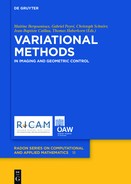Contents
Maïtine Bergounioux
Second-order decomposition model for image processing: numerical experimentation
1.3.1Discretized problem and algorithm
1.3.5Sensitivity with respect to sampling and quantification
1.3.6Sensitivity with respect to parameters
Laurent Hoeltgen, Markus Mainberger, Sebastian Hoffmann, Joachim Weickert, Ching Hoo Tang, Simon Setzer, Daniel Johannsen, Frank Neumann, and Benjamin Doerr
Optimizing spatial and tonal data for PDE-based inpainting
2.2A review of PDE-based image compression
2.2.2Finding good inpainting operators
2.2.5Fast algorithms and real-time aspects
2.2.6Hybrid image compression methods
2.2.7Modifications, extensions and applications
2.2.8Relations to other methods
2.3Inpainting with homogeneous diffusion
2.4Optimization strategies in 1D
2.4.1Optimal knots for interpolating convex functions
2.4.2Optimal knots for approximating convex functions
2.5Optimization strategies in 2D
2.6Extensions to other inpainting operators
Qian Xie and Anuj Srivastava
Image registration using phase–amplitude separation
3.2Definition of phase–amplitude components
3.2.1q-Map and amplitude distance
3.2.2Relative phase and image registration
3.3Properties of registration framework
3.4Gradient method for optimization over Γ
3.4.2Mean image and group-wise registration
3.5.1Pairwise image registration
3.5.2Registering multiple images
Martin Eller and Massimo Fornasier
Rotation invariance in exemplar-based image inpainting
4.2Rotation invariant image pattern recognition
4.2.3Mutual angle detection algorithms
4.2.4Rotation invariant L2-error using the circular harmonics basis
4.2.5Rotation invariant gradient-based L2-errors and the CH-basis
4.3Rotation invariant exemplar-based inpainting
4.4.3Conclusion and future perspectives
José A. Iglesias and Clemens Kirisits
Convective regularization for optical flow
5.2.2Convective regularization
5.2.3Data term and contrast invariance
Elena Beretta, Monika Muszkieta, Wolf Naetar, and Otmar Scherzer
A variational method for quantitative photoacoustic tomography with piecewise constant coefficients
6.1Quantitative photoacoustic tomography
6.1.2Contributions of this article
6.2Recovery of piecewise constant coefficients
6.3A Mumford–Shah-like functional for qPAT
6.4Implementation and numerical results
ASpecial functions of bounded variation and the SBV-compactness theorem
Martin Burger, Hendrik Dirks, and Lena Frerking
On optical flow models for variational motion estimation
7.2.1Variational models with gradient regularization
7.2.2Extension of the regularizer
7.4.2Discretization and parameters
7.5.1Error measures for velocity fields
Luca Calatroni, Chung Cao, Juan Carlos De los Reyes, Carola-Bibiane Schönlieb, and Tuomo Valkonen
Bilevel approaches for learning of variational imaging models
8.1Overview of learning in variational imaging
8.2The learning model and its analysis in function space
8.2.2Existence and structure: L2-squared cost and fidelity
8.3Numerical optimization of the learning problem
8.4.1Total variation-type regularization
8.4.2Optimal parameter choice for TV-type regularization
8.5.3Multiple noise estimation
Piernicola Bettiol and Nathalie Khalil
Non-degenerate forms of the generalized Euler–Lagrange condition for state-constrained optimal control problems
Piernicola Bettiol, Bernard Bonnard, Laetitia Giraldi, Pierre Martinon, and Jérémy Rouot
The Purcell three-link swimmer: some geometric and numerical aspects related to periodic optimal controls
10.2First- and second-order optimality conditions
10.3The Purcell three-link swimmer
10.4Local analysis for the three-link Purcell swimmer
10.4.1Computations of the nilpotent approximation
10.4.2Integration of extremal trajectories
10.5.3The Purcell swimmer in a round swimming pool
10.6Conclusions and future work
Zheng Chen and Yacine Chitour
Controllability of Keplerian motion with low-thrust control systems
11.2.2Study of the drift vector field in ?
11.2.3Admissible controlled trajectory of Σsat
11.2.4Controlled problems in ?
11.4.1A numerical example for OIP
11.4.2A numerical example for DOP
Thierry Combot
Higher variational equation techniques for the integrability of homogeneous potentials
12.1Introduction: integrable systems
12.2An algebraic point of view
12.2.1Algebraic presentation of a Hamiltonian system
12.2.2First-order variational equations
12.2.3Differential Galois theory
12.3Introduction to Morales–Ramis theorem
12.3.1The Morales–Ramis theorem
12.3.3Higher variational equations
12.4Application to parametrized potentials
12.4.1Space of germs of integrable potentials
12.4.2Eigenvalue bounding of some n-body problems
Jacques Féjoz
Introduction to KAM theory with a view to celestial mechanics
13.1Twisted conjugacy normal form
13.2One step of the Newton algorithm
13.4Local uniqueness and regularity of the normal form
13.6Invariant torus with prescribed frequency
13.7Invariant tori with unprescribed frequencies
13.10Example in the spatial three-body problem
CInterpolation of spaces of analytic functions
Marek Grochowski and Wojciech Kryński
Invariants of contact sub-pseudo-Riemannian structures and Einstein–Weyl geometry
14.5Contact sub-pseudo-Riemannian symmetries
14.6Appendix: Isometries in dimension 5
Jérôme Lohéac and Jean-François Scheid
Time-optimal control for a perturbed Brockett integrator
15.2Controllability and time-optimal controllability
15.3An approximate linearized time-optimal control problem
15.4Numerical computation of a time-optimal trajectory
15.4.1Finite-dimensional minimization problem
15.5Application to time-optimal micro-swimmers
15.5.1Modeling and problem formulation
15.5.2Numerical computation of a time-optimal trajectory
Jean-Pierre Marco
Twist maps and Arnold diffusion for diffeomorphisms
16.1From Arnold diffusion to twist maps
16.3.2Implementation of Moeckel’s method
16.3.3Normally hyperbolic shadowing
16.3.4Conclusion of the proof of Theorem 1
Gianna Stefani and Pierluigi Zezza
A Hamiltonian approach to sufficiency in optimal control with minimal regularity conditions: Part I
17.2Notations and preliminary results
17.2.2The Pontryagin maximum principle
17.3A Hamiltonian approach to optimality
17.3.2The super-Hamiltonian and its properties
17.3.3Abstract sufficient optimality conditions

